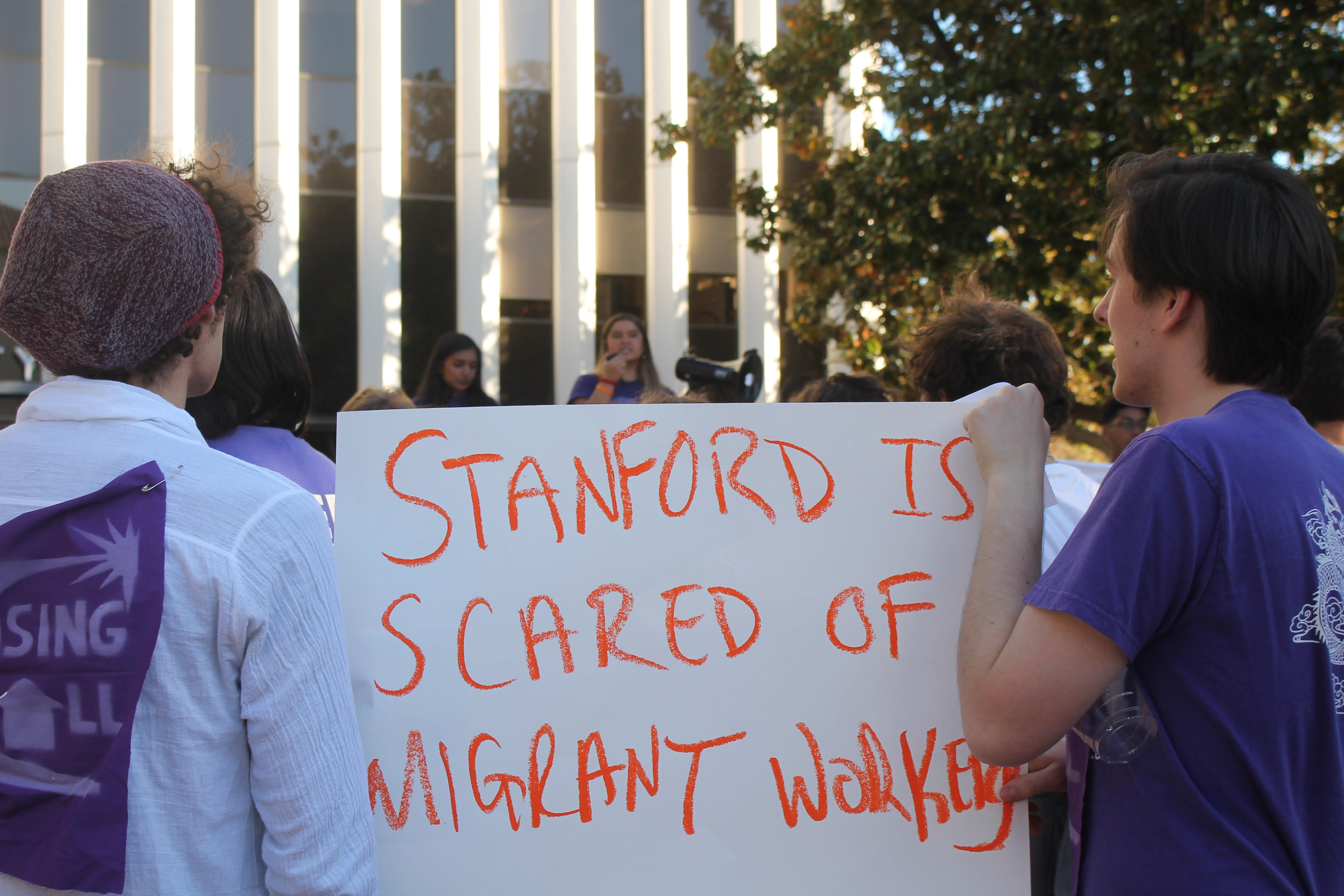Over a hundred Stanford community members, clad in purple t-shirts and neon-yellow stickers reading “FULL MITIGATION,” sat on the ground of the lobby at Palo Alto City Hall on Tuesday, intently watching a livestream of the Santa Clara County public hearings. It was the final hearing on Stanford’s General Use Permit (GUP) in Palo Alto, and the Stanford community, organized by the Stanford Coalition for Planning an Equitable 2035 (SCoPE), showed up in full force. The City Hall became so crowded that the fire marshall relocated many of the students and community members outside.
Streams of city councilmen and supervisors testified about the GUP application, which outlines the University’s planned growth over the next two decades. Not long after Stanford submitted the proposal in November 2016, students formed SCoPE to advocate for affordable housing for service workers, environmentally sustainable transportation options and fair labor standards.
Tuesday’s hearing marked the final stages of over three years of community involvement before Santa Clara’s Board of Supervisors begin final deliberations on Nov. 5.
“This is the last GUP hearing that will take place in Palo Alto,” said Shelby Parks ’19 M.S. ’20 and Kate Ham ‘20, members of SCoPE. “It’s the last chance for students to show up, make our voices heard, and influence what the next 20 years of Stanford’s development will look like.”
The GUP proposal underwent several rounds of community feedback and county reviews before public hearings began in May. At every step of the process, SCoPE has called for the County to impose additional housing, environmental and labor guidelines on Stanford’s permit request.
The final set of public hearings began on Oct. 8, at which point the County and University found themselves at a standstill over the question of a development agreement. This kind of contract determines upfront all the benefits that Stanford will be required to provide the County for the duration of the GUP.
Stanford Vice President Bob Reidy doubled down on the development agreement question at Tuesday’s hearing.
“We made it very clear that we don’t believe we can accept the permit without the protections of predictability, which is what we offered through the development agreement,” he told county Supervisor Joe Simitian. “We don’t believe there will be housing without the protections of a development agreement.”
At the forefront on Tuesday were questions about housing affordability and reduced per-pupil school funding. According to Ham, many of the estimated 250 students who appeared at Tuesday’s rally have not traditionally been directly involved in campus activism.
“A lot of the students want to have tangible impacts with their activism … SCoPE has really made that more actionable,” Ham said.
SCoPE is unique in its engagement with the Stanford community, allying with undergraduate cultural associations, the graduate student body, the ASSU, and the staff, whose rights are core to the group’s activism.
SCoPE has partnered with SEIU 2007, the labor union on campus that represents directly employed workers. Signs labeled “WE STAND WITH WORKERS” lay strewn on the ground during the hearing.
Doroteo Garcia, a janitor on Stanford’s campus since 2001, addressed the crowd on the housing struggles campus workers face.
“My coworkers and I feel proud to work at Stanford, but we would be even more proud to work at Stanford if during this project they would consider building affordable housing units for their low-income workers,” he said.
In addition to Stanford’s workers, SCoPE’s platform includes advocating for the University’s graduate students. Ph.D. candidate Justine Modica was invited to speak at the rally on behalf of the Stanford Solidarity Network (SSN) and the Parent Alliance.
“Stanford maintains large Ph.D. programs because we do work that the University relies on to function, that makes it possible for Stanford to exist as a top research institutions,” Modica told the crowd. “Like our brothers and sisters in SEIU we’re out here today to demand fair treatment as workers, to demand affordable childcare and healthcare.”
Modica said Stanford’s lack of childcare created institutional barriers for women in academia, who were forced to choose between pursuing a degree or raising a family.
“Women will remain underrepresented in the academy for as long as childcare and family housing are as affordable as they are here at Stanford now,” Modica said.
SCoPE recognized that Santa Clara County, rather than the Stanford administration, had final say in Stanford’s GUP, and has used the local political process to push their platform.
“When you take into account all these outside political levers, it makes it a lot more likely that Stanford will respond to outside demands,” said ASSU President Erica Scott ‘20.
“As we’re going into the year, there’s a lot of long range planning that’s occurring that’s going to affect students and generations and workers for years to come,” added ASSU Vice President Isaiah Drummond ’20. “We’re hoping that students are not going to be so inundated with information that they give up, but that this turnout is representative of things that are going to happen in the future.”
This article has been updated to note that Justine Modica spoke at the rally as a representative of the Stanford Solidarity Network (SSN) and the Parent Alliance.
Contact Lena Han at lahan ‘at’ stanford.edu and Grace Carroll at gac23 ‘at’ stanford.edu.
